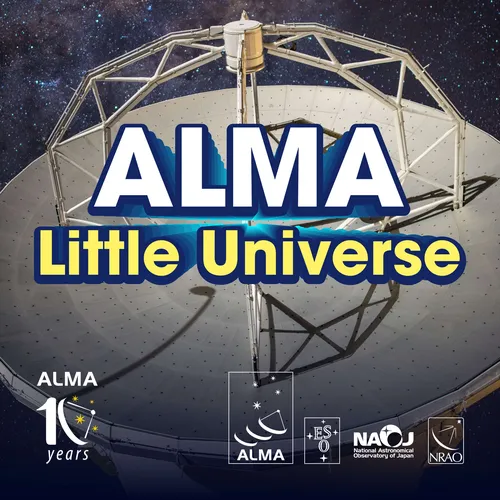
ALMA Little Universe
Journey into the 'Little Universe of ALMA' and uncover the wonders of our cosmic origins. In bite-sized episodes ranging from 3 to 6 minutes, delve into the intricacies of the ALMA Observatory, stationed in the heart of the Atacama Desert. Discover galaxies shrouded in stardust, the first-ever image of a black hole, and even a simplified form of sugar, all made possible by 66 colossal antennas that peer into the Universe with unparalleled depth. Embark on this enlightening journey and learn how ALMA connects us to the vast expanse of the Cosmos.
This podcast was produced by Paige Cromley during her internship at ALMA from Princeton University.
- Update frequency
- every 7 days
- Average duration
- 3 minutes
- Episodes
- 24
- Years Active
- 2023 - 2024

What are ALMA future science goals?
Nobody interested in science and the Universe could ignore the existence of black holes and protoplanetary discs. Do you know about these discs? In the last ten years, ALMA has changed how we view th…

Did the Observatory shut down over the Pandemic?
Undoubtedly, the COVID-19 pandemic was a problem for all humankind, and its effects were seen in almost any imaginable aspect. Consequently, how did COVID-19 affect ALMA's functionality? Was there a …

Who works at ALMA?
We have discussed widely the technologies and processes that made ALMA possible. Nevertheless, there could be no observatory if there were not people from more than 20 countries and many disciplines …

What's an ALMA fellow?
In the previous episodes of ALMA's Little Universe, we have described the technologies and many of the processes and labors that made the observatory's operations possible. Nevertheless, we have not …

What kind of data does ALMA produce?
In this episode of ALMA's Little Universe, we will deepen our knowledge about how the raw data collected through the telescope becomes images intelligible by the human eye.
How does the binary code in…

Where does the data go after observation?
How do the raw data collected from the antennas become images from distant galaxies? In this episode, Drew Brisbin and Chin-Shin Chang, two scientists from the Science Archive Content Management, wil…

What happens in the Control Room?
Though most engineering and technical works of ALMA occur during the daytime, astronomical observations can run day and night since the telescope is sensible to radio waves, which do not interfere wi…

Why are there medical tests before going to the high site?
ALMA's 66 antennas are located in the Array Operation Site (or AOS for short), a 40-minute drive from the observatory's camp. As AOS is 5,000 meters above sea level, anyone working there must be subj…

Who keeps the residency running?
As we have known in our last episode of ALMA's Little Universe, OSF staff, during their shifts, are provided with many services that guarantee their comfort and proper work in the heights of the Atac…

Whats at OSF?
In this episode of ALMA's Little Universe, we will discuss how the Operation Support Facility is equipped to give their workers all the comforts and services needed, even at almost 3000 meters altitu…

Whats a shift at OSF?
On the Chajnantor Plateau, at 5000 meters altitude, there are the 66 antennas that constitute the ALMA radio telescope. 2 kilometers below is the Operation Support Facility, where many engineers, tec…

Do the antennas ever break?
The antennas are located in the Atacama Desert at 5000 meters altitude and are constantly exposed to extreme weather conditions and temperatures. How much time will they last? Are they durable throug…

Why are the Receiver Bands keep so cold?
As we have stated in our previous episode, ALMA's multiple receiver bands are used to detect signals from the sky. However, these receiver bands must be kept at very cold temperatures to work properl…

What is the Correlator?
How does the supercomputer that translates to binary code all the information received by ALMA antennas operate? In this episode, Lorenzo Martínez-Conde, an engineer who has been working at ALMA Obse…

What is interferometry?
We have already referred to the 66 antennas that make up ALMA, but how do they operate as one telescope? In this episode, Giorgio Siringo, Senior Radio-Frequency Engineer, will explain how interferom…

What makes up the antennas?
What technologies have made it possible for the ALMA Observatory to observe and analyze with the accuracy of a human hair in distances of light-years? In this episode, Mark Galilei, technical mechani…

How do they move the antennas?
The 66 antennas of the ALMA Observatory operate in different configurations of distance between each of them to help scientists from various fields observe and analyze the previously unreachable and …

Are all the Antennas the same?
Sixty-six antennas working together made possible the operation of ALMA Observatory.
How can this telescope in the Atacama Desert see a whole part of the Cosmos that could not be seen before? In this …

Who's paying for all this?
The construction cost of ALMA is estimated at over a billion US dollars, and every year of operation involves millions of dollars of investment and resources. Twenty-one countries from all around the…